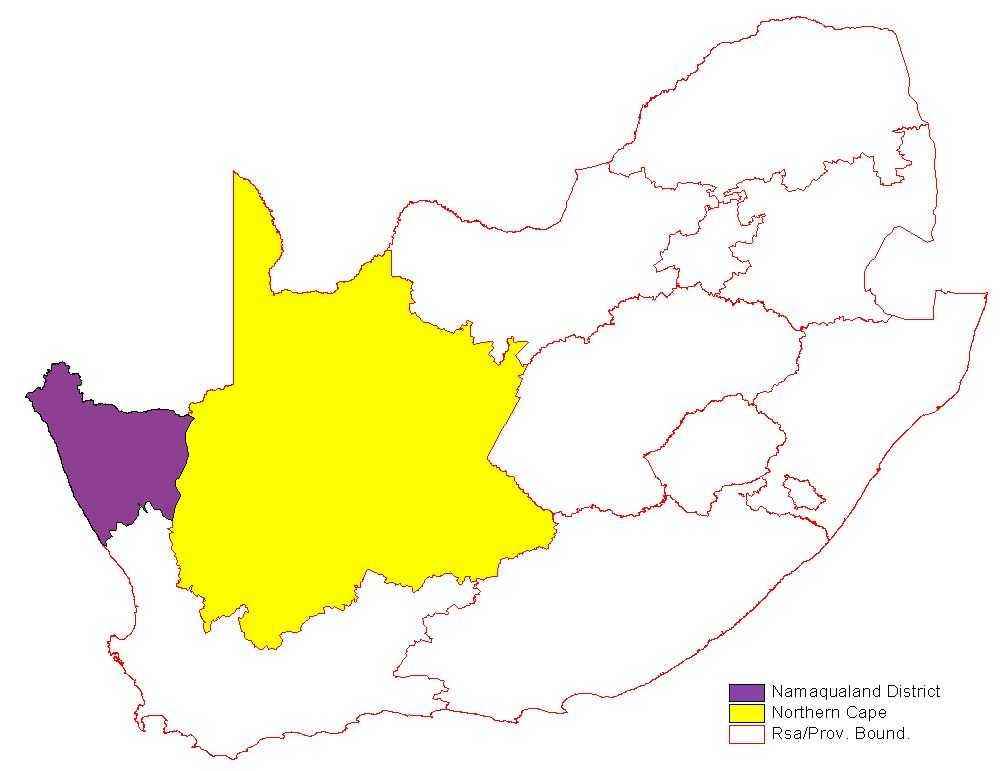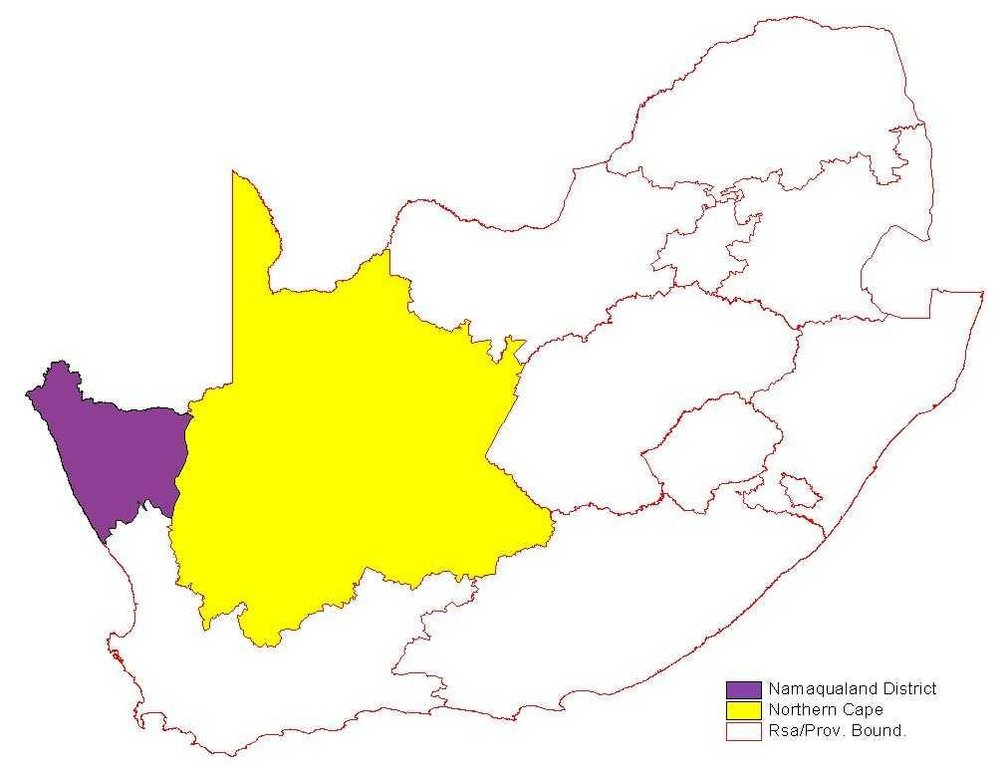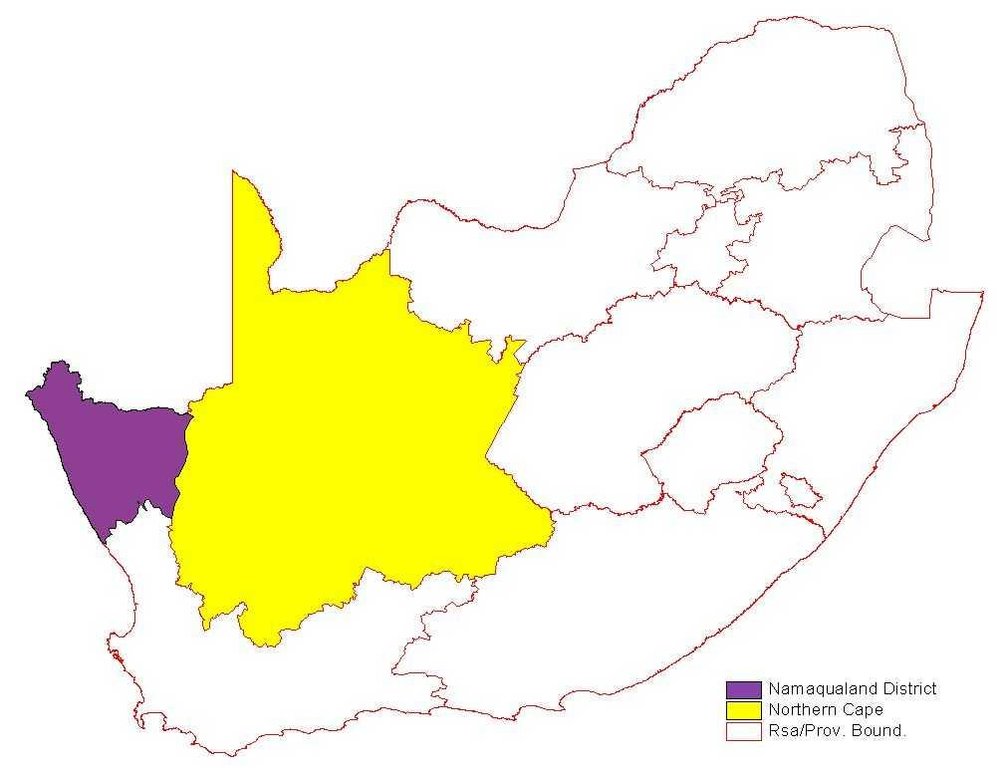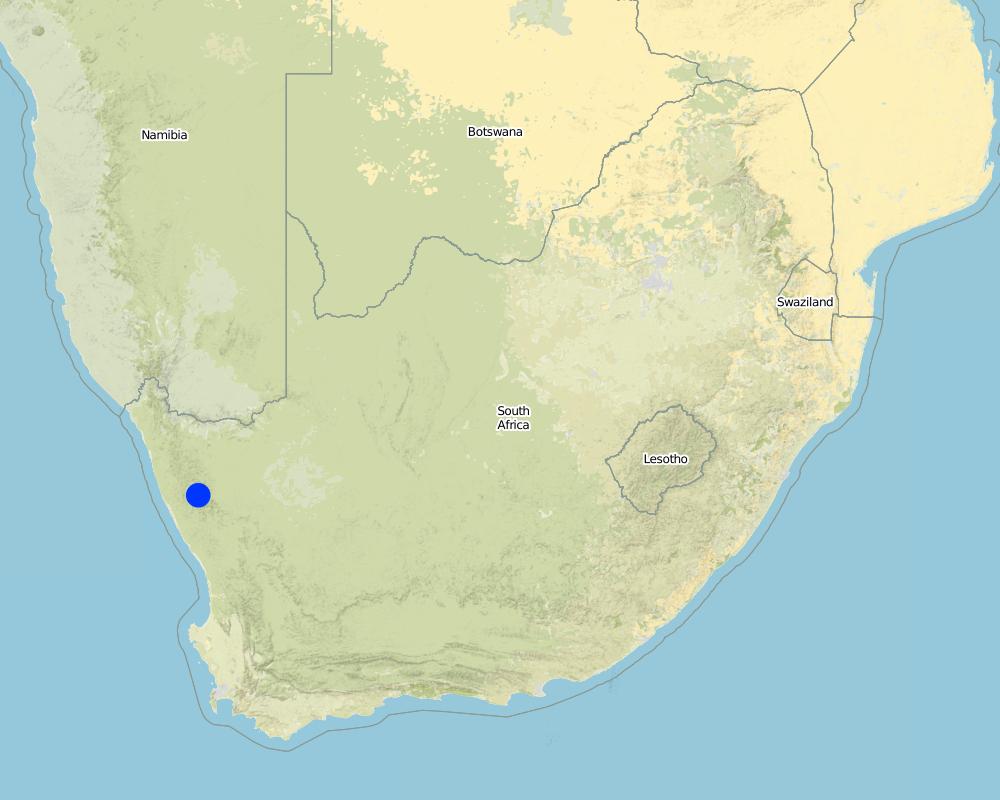Awareness raising [南非]
- 创建:
- 更新:
- 编制者: Belly Mpoko Malatji
- 编辑者: –
- 审查者: Fabian Ottiger
approaches_2344 - 南非
查看章节
全部展开 全部收起1. 一般信息
1.2 参与方法评估和文件编制的资源人员和机构的联系方式
有助于对方法进行记录/评估的机构名称(如相关)
Dept. of Agriculture, Northern Cape (Dept. of Agriculture, Northern Cape) - 南非1.3 关于使用通过WOCAT记录的数据的条件
编制者和关键资源人员接受有关使用通过WOCAT记录数据的条件。:
是
1.4 SLM技术问卷的参考
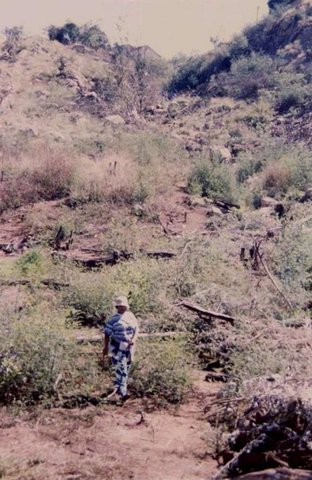
Combating of invader plants and bush packing [南非]
The combating of Invaders to preserve water resources & the rehabilitation of the bare ground by means of brush packing to prevent soil erosion.
- 编制者: Unknown User
2. SLM方法的描述
2.1 该方法的简要说明
To make the people aware of veld degradation, rehabilitation & the participation of the people
2.2 该方法的详细说明
该方法的详细说明:
Aims / objectives: Improve standard of living of community members by making handcrafts and selling wood. It is an approach where the community is fully involved (a demand driven project). Training of the people to do packing and cutting of branches.
2.3 该方法的照片
2.5 采用该方法的国家/地区/地点
国家:
南非
区域/州/省:
Northern Cape
Map
×2.7 方法的类型
- 基于项目/方案
2.8 该方法的主要目的/目标
The Approach focused mainly on SLM with other activities (Rehabilitation (veld reinforcement))
Community awareness. Training. Education
The SLM Approach addressed the following problems: Language. Literacy. Understanding of the social & cultural structure
2.9 推动或妨碍实施本办法所适用的技术的条件
社会/文化/宗教规范和价值观
- 阻碍
Treatment through the SLM Approach: Lobbed with indigenous people that is familiar with the people & the area
财务资源和服务的可用性/可得性
- 阻碍
Treatment through the SLM Approach: NGO's financial support
法律框架(土地使用权、土地和水使用权)
- 阻碍
The existing land ownership, land use rights / water rights greatly hindered the approach implementation People don't own the land
了解SLM,获得技术支持
- 阻碍
Treatment through the SLM Approach: Training of land users
3. 相关利益相关者的参与和角色
3.1 该方法涉及的利益相关者及其职责
- 当地土地使用者/当地社区
Community
Working land users were mainly women. Communication break down
- NGO
Food & social
- 国家政府(规划者、决策者)
- 国际组织
Agriculture
3.2 当地土地使用者/当地社区参与该方法的不同阶段
| 当地土地使用者/当地社区的参与 | 指定参与人员并描述活动 | |
|---|---|---|
| 启动/动机 | 无 | |
| 计划 | 互动 | Mainly: public meetings, rapid/participatory rural appraisal; partly: interviews/questionnaires |
| 实施 | 互动 | Mainly: responsibility for minor steps; partly: responsibility for major steps |
| 监测/评估 | 无 | |
| Research | 无 |
3.4 有关SLM技术选择的决策
具体说明谁有权决定选择要实施的技术:
- 主要是SLM专家,咨询土地使用者之后
解释:
consultative.
Decisions on the method of implementing the SLM Technology were made by mainly by SLM specialists with consultation of land users. land user driven (bottom-up).
4. 技术支持、能力建设和知识管理
4.1 能力建设/培训
是否为土地使用者/其他利益相关者提供培训?:
是
明确受训人员:
- 土地使用者
- school children/students, politicians/decision mak
培训形式:
- 在职
- 示范区域
- 公开会议
- 课程
涵盖的主题:
Rehabilitation, degradation, production increase, awareness, branch packing
4.2 咨询服务
土地使用者有权使用咨询服务吗?:
是
- Homes of community members
说明/注释:
1) Mainly: government's existing extension system, Partly: non-governmental agency 2) Mainly: government's existing extension system, Partly: non-governmental agency; Extension staff: mainly government employees 3) Target groups for extension: land users,
Advisory service is quite adequate to ensure the continuation of land conservation activities
4.3 机构强化(组织发展)
是否通过这种方法建立或加强了机构?:
- 是,非常
具体说明机构的强化或建立程度:
- 本地
具体说明支持类型:
- 能力建设/培训
4.4 监测和评估
监测和评估是该方法的一部分吗?:
是
注释:
bio-physical aspects were regular monitored
technical aspects were ad hoc monitored
socio-cultural aspects were regular monitored
economic / production aspects were regular monitored
area treated aspects were regular monitored
no. of land users involved aspects were regular monitored
management of Approach aspects were regular monitored
There were few changes in the Approach as a result of monitoring and evaluation: More people get involved, more meetings
4.5 研究
研究是该方法的一部分吗?
是
提供进一步的细节,并指出是谁做的研究:
Research was carried out on-farm
5. 融资和外部物质支持
5.1 该方法中SLM组成部分的年度预算
如果不知道准确的年度预算,请给出一个范围:
- < 2,000
注释(例如主要的资助来源/主要捐助者):
Approach costs were met by the following donors: government (national): 80.0%; international non-government (-): 10.0%; local community / land user(s) (-): 10.0%
5.2 为土地使用者提供财政/物质支援
土地使用者是否获得实施该技术的财政/物质支持?:
是
5.3 对特定投入的补贴(包括劳动力)
- 设备
| 具体说明哪些投入得到了补贴 | 程度如何 | 对补贴做出具体说明 |
|---|---|---|
| 工具 | 充分融资 | |
- 农业
| 具体说明哪些投入得到了补贴 | 程度如何 | 对补贴做出具体说明 |
|---|---|---|
| 种子 | 充分融资 | |
| 化肥 | 充分融资 | |
- 基建
| 具体说明哪些投入得到了补贴 | 程度如何 | 对补贴做出具体说明 |
|---|---|---|
| Community infrastructure | 充分融资 | |
如果土地使用者的劳动力是一项重要的投入,那么是不是:
- 以现金支付
5.4 信用
是否根据SLM活动的方法给予信用值?:
否
6. 影响分析和结论性陈述
6.1 方法的影响
该方法是否帮助土地使用者实施和维护SLM技术?:
- 否
- 是,很少
- 是,中等
- 是,支持力度很大
Control grazing, look after the rangelands
该方法是否改善了阻碍SLM技术实施的土地使用权/用户权问题?:
- 否
- 是,很少
- 是,中等
- 是,支持力度很大
People must increase field land on behalf of the cattle - it is not their own land
Did other land users / projects adopt the Approach?
- 否
- 是,很少
- 是,中等
- 是,支持力度很大
6.3 方法活动的可持续性
土地使用者能否维持通过该方法实施的措施(无外部支持的情况下)?:
- 是
若是,请说明如何维持:
Only financial support
6.4 该方法的长处/优点
| 土地使用者眼中的长处/优势/机会 |
|---|
| Training of extension officers |
| 编制者或其他关键资源人员认为的长处/优势/机会 |
|---|
| Community participation |
| Awareness |
| Technology transfer |
| Improve life standard |
| Better understanding of social structure |
6.5 该方法的弱点/缺点以及克服它们的方法
| 土地使用者认为的弱点/缺点/风险 | 如何克服它们? |
|---|---|
| Short term benefit is very low | |
| Not all the people were involved, difficult to keep all the people together |
| 编制者或其他关键资源人员认为的弱点/缺点/风险 | 如何克服它们? |
|---|---|
| Slower acceptance | |
| To be sustainable you have to pay the people | |
| continuous motivation |
7. 参考和链接
7.1 方法/信息来源
- 实地考察、实地调查
- 与土地使用者的访谈
链接和模块
全部展开 全部收起链接

Combating of invader plants and bush packing [南非]
The combating of Invaders to preserve water resources & the rehabilitation of the bare ground by means of brush packing to prevent soil erosion.
- 编制者: Unknown User
模块
无模块


